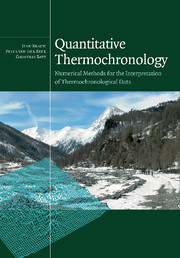Book contents
- Frontmatter
- Contents
- Preface
- 1 Introduction
- 2 Basics of thermochronology: from t–T paths to ages
- 3 Thermochronological systems
- 4 The general heat-transport equation
- 5 Thermal effects of exhumation
- 6 Steady-state two-dimensional heat transport
- 7 General transient solution – the three-dimensional problem
- 8 Inverse methods
- 9 Detrital thermochronology
- 10 Lateral advection of material
- 11 Isostatic response to denudation
- 12 The evolution of passive-margin escarpments
- 13 Thermochronology in active tectonic settings
- Appendix 1 Forward models of fission-track annealing
- Appendix 2 Fortran routines provided with this textbook
- Appendix 3 One-dimensional conductive equilibrium with heat production
- Appendix 4 One-dimensional conductive equilibrium with anomalous conductivity
- Appendix 5 One-dimensional transient conductive heat transport
- Appendix 6 Volume integrals in spherical coordinates
- Appendix 7 The complementary error function
- Appendix 8 Pecube user guide
- Appendix 9 Tutorial solutions
- References
- Index
1 - Introduction
Published online by Cambridge University Press: 15 December 2009
- Frontmatter
- Contents
- Preface
- 1 Introduction
- 2 Basics of thermochronology: from t–T paths to ages
- 3 Thermochronological systems
- 4 The general heat-transport equation
- 5 Thermal effects of exhumation
- 6 Steady-state two-dimensional heat transport
- 7 General transient solution – the three-dimensional problem
- 8 Inverse methods
- 9 Detrital thermochronology
- 10 Lateral advection of material
- 11 Isostatic response to denudation
- 12 The evolution of passive-margin escarpments
- 13 Thermochronology in active tectonic settings
- Appendix 1 Forward models of fission-track annealing
- Appendix 2 Fortran routines provided with this textbook
- Appendix 3 One-dimensional conductive equilibrium with heat production
- Appendix 4 One-dimensional conductive equilibrium with anomalous conductivity
- Appendix 5 One-dimensional transient conductive heat transport
- Appendix 6 Volume integrals in spherical coordinates
- Appendix 7 The complementary error function
- Appendix 8 Pecube user guide
- Appendix 9 Tutorial solutions
- References
- Index
Summary
Thermochronology is a technique that permits the extraction of information about the thermal history of rocks. It is based on the interplay between the accumulation of a daughter product produced through a nuclear decay reaction in the rock (whether this daughter product be an isotope or some sort of structural damage to the mineral lattice) and the removal of that daughter product by thermally activated diffusion. Because temperature increases with depth in the Earth's lithosphere, this temperature information can be translated into structural information – thermochronological data thus contain a record of the depth below the surface at which rocks resided at a given time. For eroding basement terrains, where rocks have been brought to the surface from depths of several to several tens of kilometres, thermochronology is the only technique that will provide such information and permit one to constrain the timing of rock exhumation towards the surface quantitatively.
However, the relationships among vertical motions, temperature history and the accumulation of daughter product (the present-day abundance of which will provide a thermochronological age) are highly non-linear and depend on many parameters. To the Earth scientist seeking to constrain geological history, this presents a dichotomy. On the one hand, such thermochronological datasets have the potential to offer insight into how parameters that influence the thermal history of a geological sample vary over time.
- Type
- Chapter
- Information
- Quantitative ThermochronologyNumerical Methods for the Interpretation of Thermochronological Data, pp. 1 - 18Publisher: Cambridge University PressPrint publication year: 2006



